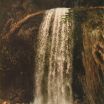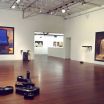Fleshed Out
Fleshed Out
Year: 2002
Medium: Vutek prints, bronze
Exhibited:
Roslyn Oxley Gallery, Sydney
Helen Lempriere Sculpture prize, Werribee Park, Werribee, Vic
National Sculpture prize, National Gallery Canberra
Lake Macquarie City Art Gallery, Lake Macquarie NSW
Press Release:
Julie Rrap’s exhibition, Fleshed Out, at Roslyn Oxley9 Gallery consists of a series of negative bronze casts of the artist posing as the main figures from iconic nineteenth-century French paintings by Gustav Courbet, Paul Gauguin and Edouard Manet. Exhibited along-side these sculptures are life-sized, digitally-manipulated prints on canvas of the original paintings from which the same figures have been removed. With these works, Rrap invites the viewer to enter the scene, to place themselves into these famous compositions.
There is a certain irony in Rrap’s interference with these canonical works of early modernism which, in their time, effected a flattening and disruption of pictorial space, a sort of dematerialisation in their depiction of human form. In her sculptures, Rrap uses the body like a seal that imprints itself upon the world that it inhabits, an indubitable impression made by a definite corporeal presence. But these bodies are also somehow invisible. In Rrap’s ‘photo-paintings’, the principal figures have succumbed to the annihilating force of photography that, she claims, evacuates the life-presence of the human form.
In explaining these new works, Rrap refers to a 1961 performance by Claes Oldenburg where a studio photography session is staged. Each time the photographer attempts to capture the posing family on film, his clients collapse, pre-empting the death to which they would have been subject in the seeming morgue of the photographer’s emulsion. Thus, the figures in Rrap’s negative bronze sculptures are like traces of some original presence while in her photo-paintings the figures have been digitally excised. Both the sculptures and prints in Rrap’s exhibition point to the figure in absentia, a gesture initiated by photography. This contradiction is of interest as photography is normally thought to be a medium for capturing ‘real presence’.
















